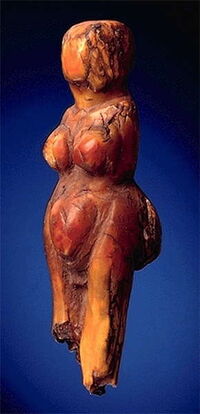
The Brown Ivory Figurine
The Brown Ivory Figurine, Figurine en Ivoire Brun, or Abrachiale, is a nearly complete female Venus Figurine made from partially fossilised Ivory found at Balzi Rossi and measures 67.6 mm high. The width at the chest is 17.2 mm and 20 mm at the hips. The maximum thickness between the buttocks and the front of the belly is 22.7 mm. Its weight is 19.37 g.
Upon its discovery a thick coat of varnish applied by Jullien, its discoverer, has given it a red to yellowish-red color, making it impossible to tell if Red Ochre had ever been applied to its surface.
Appearance
The nearly circular head lacks any indication of facial features or hair and no arms or hands are present. The roughly hemispherical breasts are large and separated from each other by a deep groove. Protruding even more than the breasts is the oval-shaped enlarged abdomen. The pubic region of this figurine is highly unusual because a deep U-shaped groove 8.5 mm wide extends from the mid-thigh into the crotch, and centred in this groove, at the base of the abdomen, is a small, carefully carved ridge in the form of an inverted crescent which is in the correct position to represent enlarged labia minora.
When viewed from the front, the head is almost circular. It is not tilted slightly downwards as can be seen on some other female figures. No facial features or representation of the hair is visible. The back of the head is narrower than the front. A deep polished groove on the back of the neck emphasises it. This groove continues to the front of the neck, marking the shoulders and suggesting the clavicles. There are neither arms nor hands. The breasts are irregularly hemispherical and separated from each other by a deep groove.
The back of the chest is flat with a shallow incision indicating, perhaps, the region of the spine. The waist is formed by a broad depression. The abdomen is oval, and is much more prominent than the breasts. It is marked off from the hips by two lateral incisions. The volume of the buttocks is very broad and they appear spherical seen from behind. They are separated by a deep but very narrow incision. The lower limbs are well shaped. The break at the knees apparently dates from the prehistoric period.
The pubic area is very unusual. Most of the statuettes of Grimaldi have a protruding mons pubis of exaggerated size with a groove or a vertical incision showing the vulva. In this piece, a deep U shaped groove, 8.5 mm wide, runs from mid-thigh to crotch. In the centre of this groove, just below the abdomen, is a small elongated horizontal slightly curved ridge. This ridge, which has not been completely cleaned of sediment, is in the place where the labia minora would be. This way of representing the genitalia has not been previously observed in other female figures of Upper Palaeolithic Europe.
Location of Origin
The figurine was carved in ivory which raises interesting problems since mammoths were not living at the time in Italy and finding their remains is rare. Scholars have speculated that the ivory figurines were either carved far from Italy and then transported to the Mediterranean shores or carved on the spot (or near it) using imported raw material. As a result of this scarcity, ivory items of any kind are exceedingly rare in Ligura, Italy, and in south-eastern France.